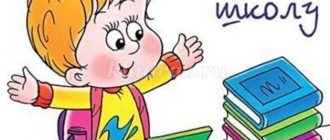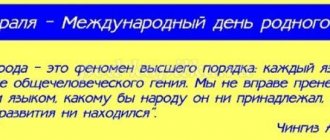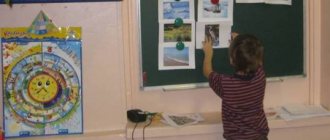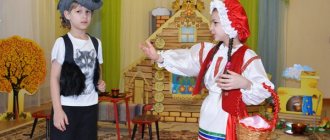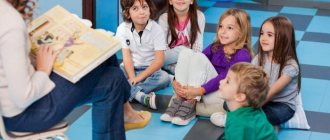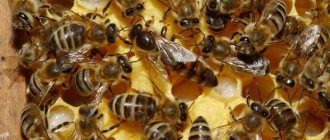Retelling in a preparatory school group
.And this is the stronger sex? Witty and funny quotes from famous people about men |
The whole truth about women: brilliant aphorisms and quotes from world celebrities
Detskiy sad.Ru >> Electronic library >> Family and children >> Education in kindergarten >> Source: E. P. Korotkova, “Teaching storytelling in kindergarten”, M., 1978 OCR Detskiysad.Ru
In preparatory to At school, the group in retelling classes consolidates and improves the speech skills acquired by children in the senior group. Preschoolers continue to learn to present texts coherently, consistently, completely, without distortion, omissions or repetitions. Children are improving their ability to convey the dialogues of the characters emotionally, with different intonations, to use semantic stresses, pauses, and certain artistic means characteristic of fairy tales (inception, repetitions, etc.) in retellings. Children learn to speak slowly, loudly enough, without tension. Children's independence increases: they learn to retell fairy tales and stories without the help of questions from the teacher. The literary and artistic material offered for retelling becomes more complex, and the number of texts increases. In the preparatory group for school, the following works are recommended for classes: Russian folk tales “The Boasting Hare”, “Fear Has Big Eyes”, “The Fox and the Goat”; stories “Four Desires”, “Morning Rays” by K. D. Ushinsky, “Bone” by L. N. Tolstoy, stories by Soviet writers: “Mushrooms” by V. Kataev, “Hedgehog” by M. Prishvin, “Bathing Bear Cubs” by V. Bianchi , “Bear” by E. Charushin, “Just an Old Lady”, “Bad” by V. Oseeva, “Strawberry” by N. Pavlova, “Green Butterflies”, “Icicle Water” by N. Sladkov, “Rivers Overflowed” by G. Skrebitsky, etc. Literary works have a huge artistic and pedagogical influence on the thoughts, feelings, interests and creative abilities of a child. Retelling activates the entire process of children’s emotional and aesthetic mastery of literary material. The artistic and speech activity of preschool children at the initial stage of its development is manifested in the form of retelling. A child of six or seven years old can more accurately correlate his retelling with the text, note possible omissions, rearrangement of material; his independence increases when analyzing his comrade’s answer. The methods and techniques used by the teacher to carry out the tasks of teaching retelling are different: expressive reading of the text two or three times, conversation about what was read, showing illustrations, speech exercises, instructions on the methods and quality of completing the task, assessment, etc. Their correct use will be evidenced by an increase from lesson to lesson in the activity and independence of children when performing educational speech tasks. It is important that in the classroom there are favorable conditions for communication, the content of which is the presentation of texts of fairy tales and stories. Using various techniques, the teacher encourages children to convey what they read clearly, clearly, clearly, to be able to address their speech to those who listen to them, to be able to clarify and supplement the answers of the narrators, showing a friendly, interested attitude towards their comrades. The accumulated experience of verbal communication is of no small importance in preparing children for school. Consider a lesson on retelling the fairy tale “The Fox and the Goat.” The Fox was running along the road, gaped at the crows and fell into the well. There is not much water in the well, you won’t drown if you drown, and you won’t jump out if you jump out. The Fox is sitting, grieving. What to do here? Here Goat is walking along the same road, waving his head, shaking his beard, looking around. Having nothing better to do, the Goat looked into the well. He saw Fox there and asked: “Great, Fox.” What are you doing here? - Yes, I’m resting. It’s hot at the top, but here it’s cool, and there’s as much cold water as you want. And the Goat has been thirsty for a long time. - Is the water good? “The water is good,” answers the Fox. - Yes, jump here and try it. There's enough room for two of us. The goat foolishly jumped. He muddied the waters and almost ran over the Fox. The Fox got angry and scolded: “Look, bearded one, he couldn’t even jump, he splashed all over.” The Fox jumped onto the Goat's back, from the back onto the horns, and out of the well! Only Kozel saw her. The Goat is sitting in the well. He sat there until the evening and didn’t know how to get out. The owner of the Goat grabbed it and went looking. I searched and searched and found it with great effort. He brought the rope and pulled the Goat out of the well. Progress of the lesson. After telling a fairy tale, the teacher conducts a conversation with the children in order to make them want to share their impressions and opinions. At the same time, he formulates the questions in such a way as to give the children the opportunity to take the initiative when evaluating fairy-tale characters and construct their statements independently: “You listened to the fairy tale with interest. What can you say about the Fox and what about the Goat? Listening to the answers, the teacher asks the children to justify their conclusions and assessments. Then the teacher draws the children’s attention to the composition of the fairy tale, to the expressive means of its language. “Remember how the Fox found herself in the well. Why did the Goat end up in the same well? What voice did the Fox speak in when she praised the coolness in the well and the cold water? How did she start talking to the Goat when he jumped into the well?” These questions lead children to make judgments about the characters' personalities. At the request of the teacher, children reproduce phrases from the dialogue with different intonations. At the end of the conversation, the question follows: “What is told at the end of the fairy tale?” Preschoolers try to concisely convey the content of this part of the fairy tale. The Fox managed to jump out of the well, and the owner pulled the Goat out. After the conversation, the teacher tells the story again and offers to retell it. Next, children practice various types of retelling. First, two or three children tell the tale from beginning to end, then the teacher suggests collectively retelling the text: one child tells the first part (until the moment the Goat jumped into the well), the other continues the retelling until the end. Let's take another lesson as an example - retelling the story by K. D. Ushinsky “Four Desires”. Progress of the lesson. Before reading the text, the teacher talks with the children about the seasons, about the entertainment and joys that winter, spring, summer, autumn bring (asks questions: “What makes you happy about winter? What makes you happy about spring? Summer? Autumn?”). Having summarized the statements, the teacher expresses confidence that children will be interested in listening to the story “Four Wishes.” After reading twice, a conversation is held on what was read. The teacher’s questions, lexically and syntactically close to the text, encourage children to convey the content of the story in detail and figuratively: “What four wishes did Mitya express? When did he wish for everything to be winter? And when did you want it to be spring? After which Mitya shared his third wish with his father - that there would be no end to summer? And when did my father write down his fourth wish in the book - that there would be no end to autumn? With his instructions, the teacher draws the children’s attention to poetic descriptions and figurative author’s speech. If the child speaks too concisely and dryly, the teacher advises him to remember how it is written in the book, or reads out the corresponding passage. For example, to the question “When did Mitya want autumn to never end?” the child answers: “When Mitya was picking apples and pears in the garden.” The teacher helps construct a statement closer to the text: “When Mitya was picking ruddy apples and yellow pears in the garden.” If during the conversation children understand with what accuracy, completeness and vividness what they read should be conveyed, then when retelling they will try to reproduce the literary material without significant omissions and with expressive intonation. At the end of the conversation, the teacher sets a creative speech task for the children - to retell the text - and reads the story again. In this case, children perceive the text with a retelling mindset. To enhance the emotional perception of a literary text, the teacher can use the technique of “mentally entering the described situation.” This activates the imagination of children in the sense that they see themselves as direct participants in the event, together with the hero they observe, reflect, be surprised, and rejoice. For example, during a conversation on V. Bianchi’s story “Bathing Bear Cubs,” the teacher addresses the children: “You listened to the story and it was as if, together with the hunter, you found yourself in a thicket of the forest and together with him you saw how a mother bear was bathing her cubs.” After such an introduction, the children answer the questions with great interest: “What did the bear do to bathe the first bear cub? What did she do with the second teddy bear?” In retelling classes, a child of six or seven years old copes well with the task of conveying the text from the character’s point of view. In order for children to quickly engage in a new learning situation, the teacher draws their attention to the central character of the work, that is, influences them with specific images. For example, the teacher suggests thinking about how the hunter himself from the story “Bathing the Bear Cubs” would tell about everything that happened. The teacher specifically formulates the question: “How will the hunter begin his story?” - and invites one or two guys to perform. Children show independence and try to give their presentation the form of direct speech: “I was walking along the bank of a forest river and suddenly I heard...” - this is how, for example, a child constructs a phrase. The teacher approves of him and asks him to continue the story. For teaching retelling, a series of works about spring can be recommended: “The Bear” by E. Charushin, “The Rivers Flooded” and “The Reluctant Traveler” by G. Skrebitsky, miniature stories by N. Sladkov “Green Butterflies”, “Icicle Water”, etc. When In this regard, it must be emphasized that the range of works for retellings should be constantly expanded, more modern fiction for children should be introduced into it. Let's consider the methodology for conducting a lesson on retelling the work of E. Charushin “Bear”. Goal: to teach children to retell consistently, completely, conveying figurative phrases and phrases, using expressive intonations. The bear was sleeping in the den, sucking its paw. The sun drove away the snow, Mishka woke up and went to the forest to get food. I was looking for last year’s berries, digging the roots and saw bees flying from the hollow. Bear wanted honey and climbed into the hollow. Yes, the bees did not give honey, they drove Mishka away. He barked, fell out of the tree and went to look for other food. The short story conveys a funny incident from the life of the forest. The language of the work is precise, emotional, and dynamic. The author uses a lot of verbs - there are eighteen of them in six lines: he slept in a den, sucked a paw, woke up, went through the forest to get food, looked for berries, dug roots, climbed into a hollow, barked, fell from a tree, etc. The rhythm of the story changes from calm to measured at the beginning to accelerated at the end. E. I. Charushin’s story can confidently be classified as a work that meets the requirement put forward by K. D. Ushinsky for a text for retellings: “It must be such that it can easily be imprinted in the minds of children; so that, having listened to the story to the end, the child remembers its middle and beginning, so that the details do not obscure the main thing...” Progress of the lesson. Before reading the text, the teacher asks the children to answer the question “Where does the bear spend the winter?” Children answer thoroughly and correctly: “The bear sleeps in a den in winter”; “He sleeps all winter in a den and sucks his paw”; "The bear makes a den for himself under a tree." “You might be interested to know,” the teacher continues, “what a bear does when he wakes up and leaves his den. You will learn about this from the story “The Bear” by Evgeny Ivanovich Charushin, which I will read to you now.” After reading, the teacher conducts a conversation with the children based on the text, the purpose of which is to help preschoolers master new phrases and figurative expressions. To the question “When did Mishka wake up?” The guys answered correctly (“In early spring”; “In spring”), but not fully and emotionally enough. The teacher asked the children to remember how this was said in the book, and read out the necessary phrase: “The sun drove away the snow - Mishka woke up.” The teacher deliberately introduced phrases from the story he had read into his questions, and the children used them in their answers. So, based on the speech sample, they remembered the expression last year's berries. To activate children's imagination, the teacher also offers questions that encourage children to express their guesses and flesh out the picture. For example: “Think about how the bear barked.” “Loudly, angrily,” the children answer. “You could hear it all over the forest.” Then the teacher asks to pronounce the word barked so that you can immediately see how angry the bear is. During the conversation, the teacher shows illustrations, and, looking at them, the children Fr. At the end of the conversation, the teacher invites the children to prepare for a retelling and reads the story again. When reading again, preschoolers penetrate deeper into the meaning of the work and perceive all events more vividly and emotionally. Some children even accompany the reading of the text with imitative movements (for example, the words roots dug). Eight people present stories during the class. As a rule, retellings are close to the author's text. The phrases used in conversation are conveyed by children especially accurately. The children’s speech during the retelling is relaxed and expressive. They pronounce the word barked in a loud, abrupt voice, in a low tone. Children's retellings are characterized by specification of the circumstances of the actions, for example: “The sun drove the snow away from the earth” instead of “The sun drove the snow away”; “Mishka climbed the tree, climbed into the hollow” - in the text “Climbed into the hollow” - etc. The children love this story and retell it expressively even one or two weeks after the lesson. N. Sladkov’s stories from the book “Sparrow’s Spring” are poetic miniatures. They can be attributed to those “little stories in a few lines,” the purpose of which K. D. Ushinsky saw in the fact that the child immediately grasped the content and conveyed it. GREEN BUTTERFLIES On the poplars, their buds strained and burst. From each bud, like a butterfly from a chrysalis, a green leaf emerged. The sparrows settled on the branches and began to peck at the sticky green butterflies. Help themselves; one peephole is up - is there a hawk, the other is down - is there a cat? ICICLE WATER There are icicles on the roofs. During the day, water drips from the icicles. This is a special water - icicle. Chiv loves icicle water very much. It will bend over from the ledge and deftly pick up with its beak an icicle droplet, similar to a droplet of the sun. After drinking water, Chiv begins to jump and chirp so desperately that passers-by stop and smile... Preparation for the retelling of the miniature “Icicle Water” is connected with observations: in early spring, children look at the icicles sparkling in the sun, listen to the ringing drops, and study the behavior of sparrows. To make it easier for children to perceive a literary work, the teacher introduces phrases and phrases taken from the story into his explanations and reveals the meaning of unfamiliar concepts and words (for example, cornice). Before reading the story “Green Butterflies,” the teacher examines with the children the bushes on which the buds are beginning to burst. “A leaf appeared as a green dot,” explains the teacher, and the children also begin to carefully examine the branches. “Here the leaf is like green tendrils,” they say. The observation continues during the lesson: the guys look at a poplar branch with green leaves, touch the leaves, and say that they are sticky. “Sticky leaves,” the teacher clarifies the children’s statement, thereby preparing them to encounter this word in the story. This is how children prepare for a meaningful and emotional perception and reproduction of literary works. The retelling again returns them to observations, which now become poetic searches and finds. After the lesson, the children run up to the bushes, find burst buds, the first leaves, and exchange impressions: “And here the green wings have already come out of the bud,” “And this is the green nose of the leaf sticking out.” THE RIVERS OVERFLOWED The river overflowed widely, flooding the meadows and swamps. Not a river, but just a huge lake. Seagulls circle over the spill; these birds have freedom when there is so much water around. Tired of flying - they sat down right on the water, rested and took off again: they were looking for small fish for dinner. THE TRAVELER RESULTS Seagulls have the freedom to fly over the flood or swim, swaying on the waves. But for the various animals and little creatures that were taken by surprise by the flood, they are simply in trouble. The fox also had to become a traveler: she climbed onto a log and floats on it, she doesn’t know where. When preparing children for retelling, the teacher must activate in their memory not only ideas accumulated in observations - on excursions, walks, but also familiar literary images. In early spring, during ice drift, the children were taken to the river, and the group read N. A. Nekrasov’s poem “Grandfather Mazai and the Hares.” The children greet the proposal to listen to a new story about the spring flood of the river in class with interest. Familiar images help to delve deeper into new ones and respond emotionally to poetic descriptions; they contribute not only to the correct reproduction of what they read, but also to its long-term, vivid preservation in children’s memory. To verify this, you can invite children to retell G. Skrebitsky’s miniatures, first seven days after the lesson, and then after two to three weeks. Children, together with the teacher, can compare old and new versions of retellings. This will allow the teacher to evaluate the effectiveness of various teaching methods. As practice has shown, children hold in memory for a long time not only the essence of the read, but also the language form of the work. With the help of retelling, children learn more and more fully stories about nature, learn to spy in the color of the sky, the foliage of trees, the flight of birds, look for a new one in a friend and talk about it interestingly, figuratively. In working with the children of the group preparatory for the school, special attention should be paid to the formation of the initial skills of educational activity - the ability to listen to the teacher’s speech, understand it, remember, act according to the instructions of the teacher. The above examples indicate that the installation for retelling is of great importance in the structure of the lesson. Usually it is given after a conversation about read, before re -reading. This contributes to a purposeful perception of the text. The general installation for retelling in the corresponding structural part of the lesson is supplemented by instructions on the nature of the retelling (collectively, in parts, in persons, from the first person, etc.). At the same time, the teacher accompanies his instructions with a speech sample so that children with specific examples can identify the features of a particular form of retelling. It should be borne in mind that a child of the seventh year of life can show greater independence in the completion of tasks. If children retell quite well, the lesson’s methodology can be changed: after reading, the installation is given for retelling, then the text is again read out and the children retell it. In this case, a detailed conversation on the read is not carried out: children have already accumulated experience in perception of works; They can show independence in the process of mastering the material and its oral presentation, adhering to the previously learned requirements for retelling quality. In conclusion, it should be emphasized once again that the retelling of literary works in the speech practice of senior preschoolers occupies a large place. The better the child assimilates various methods of retelling, the more significant his successes in mastering the monologic speech.
